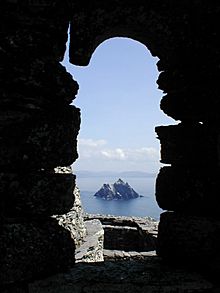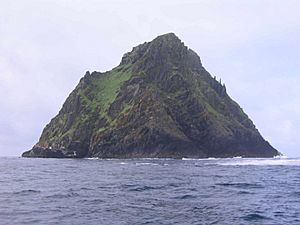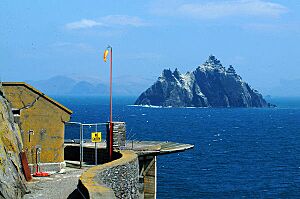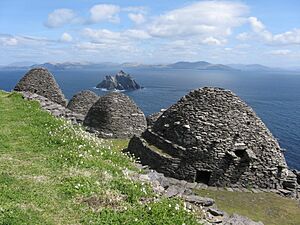Skellig Islands facts for kids

Little Skellig, as seen through the window of a hermitage on Skellig Michael
|
|
| Lua error in Module:Location_map at line 420: attempt to index field 'wikibase' (a nil value). | |
| Geography | |
|---|---|
| Location | Atlantic Ocean |
| Total islands | 2 |
| Major islands | |
| Administration | |
| County | Kerry |
| Demographics | |
| Population | 0 |
The Skellig Islands (called Na Scealaga in Irish) are two small, rocky islands. They are located about 13 kilometers (8 miles) west of Bolus Head in County Kerry, Ireland.
The larger island is called Skellig Michael. The smaller one is Little Skellig. Both islands are very important for seabirds. They form an Important Bird Area. Skellig Michael is also famous for an old Christian monastery. This monastery is a UNESCO World Heritage Site.
Contents
Little Skellig: Home to Many Birds
Little Skellig (Sceilig Bheag in Irish) is the smaller of the two islands. It is a huge home for northern gannets. Almost 30,000 pairs of these birds live here! This makes it Ireland's largest gannet colony. It is also one of the biggest in the world.
Because so many birds live there, Little Skellig is closed to visitors. The island is 134 meters (440 feet) tall. It is about 1.5 kilometers (0.9 miles) east-northeast of Skellig Michael.
Skellig Michael: A Historic Island
Skellig Michael (Sceilig Mhichíl in Irish) is also known as Great Skellig. It is the larger island. It has two peaks that rise over 230 meters (750 feet) above the sea.
An old Christian monastery from the sixth century sits high up on this island. It is about 160 meters (520 feet) above sea level. Because of this amazing monastery, Skellig Michael is a UNESCO World Heritage Site. This means it is a very special place that is important to the whole world.
Wildlife: Animals of the Skellig Islands
Both Skellig islands are famous for their large seabird colonies. They are one of the most important places in Ireland for seabirds. Many different kinds of birds live and breed here.
Bird Species
Some of the birds that make their nests on the islands include:
- European storm petrel
- Northern gannet
- Northern fulmar
- Manx shearwater
- Black-legged kittiwake
- Common guillemot
- Razorbill
- Atlantic puffin (over 4,000 puffins live on Skellig Michael alone!)
You might also spot Red-billed choughs and Peregrine falcons flying around.
Ocean Animals
The waters around the islands are full of life too. You can often see many Grey seals. Larger sea creatures have also been seen here, such as:
The clear water and many sea animals make the islands a great place for recreational diving. Divers can explore underwater cliffs that go down to 60 meters (200 feet).
Filming Location: Skellig in the Movies
The Skellig Islands have been used as a setting for several movies.
Star Wars
The final scene of Star Wars: The Force Awakens was filmed on Skellig Michael in 2015. More scenes for the next movie, Star Wars: The Last Jedi, were also filmed there. In the movies, the old monastery on Skellig Michael looks like an ancient Jedi temple.
Other Films
- The 1976 movie Heart of Glass by Werner Herzog also featured the islands.
- Some parts of the 2012 movie Byzantium were filmed here too.
Images for kids
-
Little Skellig seen from Skellig Michael
See also
 In Spanish: Islas Skellig para niños
In Spanish: Islas Skellig para niños










